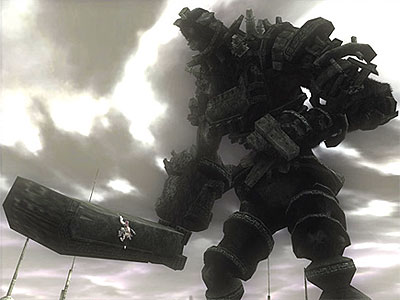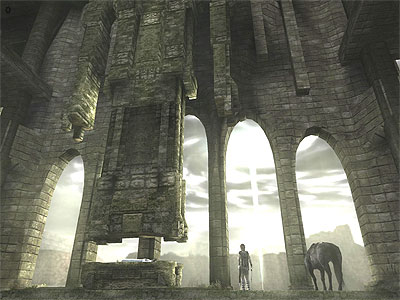Shadow of the Colossus
February 24, 2006 ・ Blog
It’s been a long, long time coming, what with another frustrating wait between its US and Euro releases, but Shadow of the Colossus is finally out over here.

Like its successor, the remarkable Ico, it pits a lonely hero against huge structures. In Ico it was a windblown, impossibly complex Mervyn Peake-like castle. In Colossus it is a series of enormous, towering creatures, seemingly made from stone and moss. The hero’s task is to find them in the beautifully empty landscape and to climb them to find their weak spot and bring them crashing to the ground.
The atmosphere is just the same as Ico’s – lonely, noble, almost wordless. You’re accompanied by Agro, a horse that you quickly strike up a strong bond with. Agro is a reversed form of Ico’s Yorda character: you’re reliant on him – he’s your mode of travel as you hunt the Colossi and he’s the only sympathetic living being in this desolate land.

I’ve defeated six Colossi now. Some of the battles have been epic, with my character tenaciously gripping and crawling across their backs with both feet and hands dug into their hides. He looks a little like vampire bats I’ve seen on TV hugging themselves against and crawling across a cow to drink. Indeed, I’m not so sure that my character is good – I seek out these Colossi and engage them without provocation. And when I bring them down, seeing them topple and crumble in slow motion as the orchestral music swells, I can’t help thinking through my victorious pride that I’m destroying things that have more rights to the land than I do.
But of course, the structure of the game doesn’t give me much power to do anything else. This is an incredibly rigid game. So was Ico: its castle directed me with sustained, smooth progression through shadowed halls to sunlit tree-filled groves in a way that felt measured and right. But Colossus takes place in a (seemingly, at least) vast, free-roaming environment, so to direct my actions, it gives me little to do other than move onto the next Colossus I’ve been asked to destroy. When I do, I’m transported back to the central location, a castle where the maiden I hope my architectural slaughter will resurrect lies, and I’m given my next target.
This structure contradicts the quiet, elegant atmosphere generated by the visuals and sound, and it makes the game feel disjointed and staccato. The great pity is that its beautiful environments feel wasted: Agro will speed me over a green plain, through a forest and over a chasm before I’ve been given a chance to anticipate and savour them in the way Ico allowed me to do.
These niggles won’t stop me finishing it, and I’m enjoying every moment of playing it. Besides, who knows, maybe the narrative will turn this structure around completely and open up the whole game? I hope so. Watch this space.